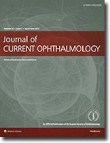Clinical Comparison of Conventional Coaxial Phacoemulsification and Coaxial Microincision Phacoemulsification
Author(s):
Abstract:
Purpose
To compare the outcomes of coaxial microincision phacoemulsification with that of conventional coaxial phacoemulsification SETTING: Department of Ophthalmology, Farabi and Noor Eye Hospitals, Tehran, Iran Methods
In a prospective study, 74 eyes of 74 patients with cataract were randomly selected to have cataract extraction using 1 of 2 techniques: coaxial microincision phacoemulsification through a 2.2 mm incision (37 eyes) or conventional coaxial phacoemulsification through a 2.8 mm incision (37 eyes) and foldable intraocular lens (IOL) (SA60; Alcon) implantation. Intraoperative parameters were effective phacoemulsification time (EPT), surgical time, and total volume of balanced salt solution (BSS) used. Assessed ocular biometrics included corneal topography, to evaluate surgically induced astigmatism (SIA), as well as corneal thickness and endothelial cell count (ECC). Results
Using vectorial analysis the amount of SIA was 0.04±0.34 diopter (D) at 126.7 degrees in the 2.8 mm group and 0.07±0.49 D at 11.8 degrees in the 2.2 mm group, at one month postoperatively. At 3 months, the SIA was 0.06±0.41 D at 134.7 degrees and 0.10±0.62 at 161.4 degrees in the 2.8 mm and 2.2 mm groups, respectively. Conclusion
Although coaxial microincision cataract surgery (MICS) was a safe and effective technique there were no clinical or statistically significant differences between 2 techniques in minimizing the effect of incision size on SIA.Language:
English
Published:
Journal of Current Ophthalmology, Volume:22 Issue: 4, 2010 Dec
Page:
13
magiran.com/p804562
دانلود و مطالعه متن این مقاله با یکی از روشهای زیر امکان پذیر است:
اشتراک شخصی
با عضویت و پرداخت آنلاین حق اشتراک یکساله به مبلغ 1,390,000ريال میتوانید 70 عنوان مطلب دانلود کنید!
اشتراک سازمانی
به کتابخانه دانشگاه یا محل کار خود پیشنهاد کنید تا اشتراک سازمانی این پایگاه را برای دسترسی نامحدود همه کاربران به متن مطالب تهیه نمایند!
توجه!
- حق عضویت دریافتی صرف حمایت از نشریات عضو و نگهداری، تکمیل و توسعه مگیران میشود.
- پرداخت حق اشتراک و دانلود مقالات اجازه بازنشر آن در سایر رسانههای چاپی و دیجیتال را به کاربر نمیدهد.
In order to view content subscription is required
Personal subscription
Subscribe magiran.com for 70 € euros via PayPal and download 70 articles during a year.
Organization subscription
Please contact us to subscribe your university or library for unlimited access!


